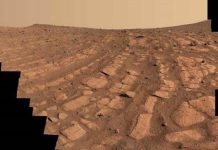
July 23 (UPI) — When Perseverance touches down on Mars early next year, the rover and its many instruments will start to probe for evidence of what the Red Planet was like billions of years ago.
And like the Mars missions that came before — from Mariner to Viking to Curiosity — Mars 2020 will operate with one eye focused on the future.
The mission’s team of scientists will also study Mars’ geologic diversity and collect a cache of rock samples to return to Earth.
In searching for the remnants of Martian environs that once proved friendly to microorganisms — and for the chemical signatures of ancient Martian organisms — researchers hope to gain insights into how NASA can support a human mission.
“The more we know about Mars, the better prepared we are to send humans there and get them home safely,” Ken Williford, deputy project scientist for the Mars 2020 mission, told UPI.
The mission is scheduled to launch July 30 from Kennedy Space Center in Florida.
After touchdown
After Perseverance touches down in February 2021, the rover will begin to look for previously habitable sites. A pair of imaging instruments, Mastcam-Z and SuperCam, will aid the hunt.
The Mastcam-Z and its variable-zoom eyes will capture panoramic and stereoscopic 3D color images in high resolution, while the rover’s SuperCam will deploy a laser to vaporize rock and study its contents with visible near-infrared light.
The SuperCam and several other instruments aboard Perseverance use spectroscopy to analyze the makeup of the rocks and sediments it samples. Spectroscopic instruments disperse an object’s light into different wavelengths. Different minerals and molecules produce different spectral patterns.
Sampling often dictated exploration on previous Mars missions, but the opposite will be true for Mars 2020. Perseverance will use its exploratory capabilities to seek out the most interesting sample sites before drilling into the Martian surface.
When Perseverance finds a site ripe with potential evidence of past life, the rover will utilize a pair of more precise rock analysis instruments: PIXL and SHERLOC.
PIXL, the X-ray lithochemistry instrument, will use X-ray fluorescence to survey a mineral’s elemental composition. SHERLOC, the Scanning Habitable Environments with Raman and Luminescence for Organics and Chemicals instrument, will use a deep-ultra-violet laser and fluorescence spectroscopy to determine fine-scale mineralogy and detect organic compounds.
Possibility of life
While the possibility of alien life on Mars has long captured the attention of the public, researchers are equally excited about the quest to unravel the Red Planet’s inorganic mysteries.
“I think we have successfully gotten the word out that we plan to seek the signs of ancient life,” Williford said. “I think this is the first mission since Viking to focus so directly and seriously on the search for extraterrestrial life.
“Perhaps less well understood by the media is the fact that our mission, and Mars Sample Return more broadly is about something much bigger than astrobiology” and the search for ancient life, he said. “We wish to understand how Mars formed, how it evolved as a planetary system and what all of that can tell us about our own planet, our solar system and our place in the universe.”
Mars 2020 is slated to land inside Mars’ Jezero Crater, positioned near the western edge of Isidis Planitia, a massive basin north of the Martian equator.
NASA scientists chose to send to Perseverance to the crater because it features an ancient lake bed and river delta and boasts a unique mix of minerals like clays, carbonates and hydrated silica. The region’s water-rich past make it an ideal place to look for signs of ancient life, but its history of water-fueled erosion also makes Jezero geologically interesting.
Even if scientists fail to find the chemical signatures of ancient life inside the crater’s layers of rock and sediment, they will surely find — with the help of Perseverance’s instruments — evidence of ancient climate conditions.
Unlike previous rover landing spots, like Gale Crater, which offered only a brief snapshot of Mars’ geologic and climate history, Jericho Crater’s varied landscape will provide geologic features that represent a 500 million-year time span.
Bringing back samples
On all previous Mars missions, geologic observations have been conducted exclusively in situ, measuring rocks and sediments in the place where they are. Mars 2020 will do plenty of in situ science, but also will do something new.
“This is the first time where we are robotically, from another planet, collecting, depositing and sealing a sample that can be brought back to Earth,” Ray Baker, an engineer at NASA’s Jet Propulsion Laboratory and flight systems manager for the Mars 2020 mission, told UPI.
Perseverance is outfitted with a pair of robotic arms, nine drill bits, a rotating storage carousel and 43 metallic tubes that will be used to target, extract and seal rock and sediment samples for future study inside laboratories on Earth.
“The baseline concept is that we collect and seal the sample,” Baker said. “The sample is retained with a hermetic seal and no contamination can get in. When we find a good location, we’ll create a cache. We’ll actually drop the samples onto the surface of Mars for a future rover to come pick up.”
NASA and the European Space Agency are planning a future Mars mission that involved the collection and return of the samples Cached by Perseverance to Earth, with a possible launch slated for 2026.





